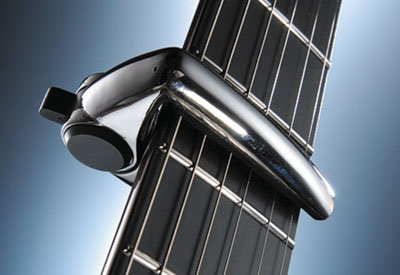capo

Trigger capo.
A capo, capodastro (Italian for 'head of fingerboard') or capo tasto, is a device used by guitarists to clamp all the strings at a given fret position, allowing open position chords to create other keys. Capos also lower the action of the strings and shorten the scale length. A shorter scale length produces a different timbre, one that is similar to that of a shorter stringed instrument.
In effect, a capo creates a new nut, so fret numbers are altered accordingly. For example, a capo on the second fret would mean that fret three is now fret one when marked in tab (guitar tablature).
Capos may be used with instruments other than the guitar, including some varieties of mandolin and the four-string banjo
Types of capo
The component common to all modern capos is a a rubber-covered bar that holds down the strings. What differs between the different types is the mechanism for clamping the bar in place.
Trigger capos
Probably the most popular type of capo used today, because it works well and can quickly be attached and released using just one hand. A trigger capo has two rubber-covered bars – a straight one to barre the strings, and a curved one to press against the back of the neck. A spring presses together the bars, which are attached by a pivot at one end. The trigger capo is the commonest design referred to as a "quick-release" capo. Its main disadvantage is that the pressure applied to the strings isn't adjustable. The spring applies its maximum pressure to hold the strings down, and this can affect the tuning of some guitars if not applied properly. Kyser and Dunlop are prominent manufacturers of this type of capo.
Strap-on capo
The strap-on capo – among the earliest styles of this device – uses an elastic or fabric band, which straps around the neck of the instrument, to hold the rubber-covered bar in place on the strings. Strap-on, or elastic, capos are relatively cheap and can be adjusted to vary the amount of pressure applied to the neck, but have the disadvantage that they are fiddly to put on and require two hands.
Screw capo
Also called a Shubb capo, after the manufacturer of this type, a capo that has a screw by means of which the pressure applied to the strings can be adjusted. This has the advantage that the minimum pressure needed to barre the strings can be applied, which in turn has the least possible impact on the tuning. A lever is used to clamp the capo, and two hands are needed put the device in place. Once on the neck, however, the screw capo can be slid around, even, in some cases, past the nut of the guitar.


